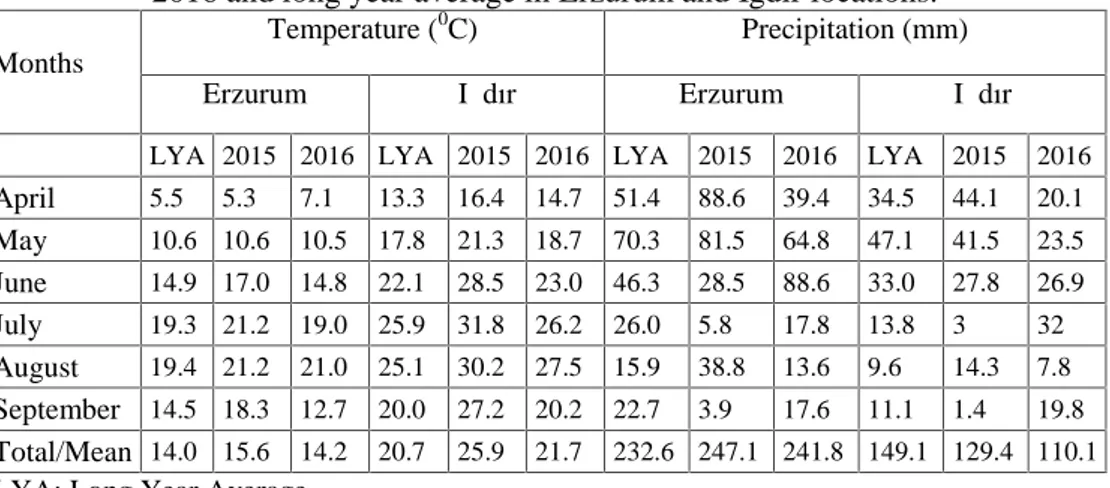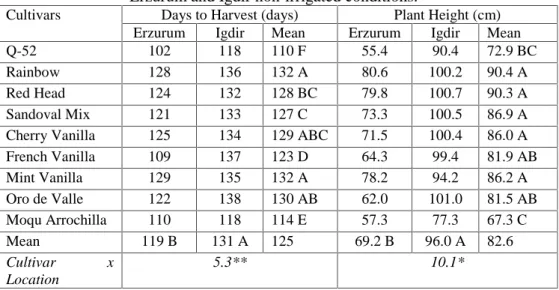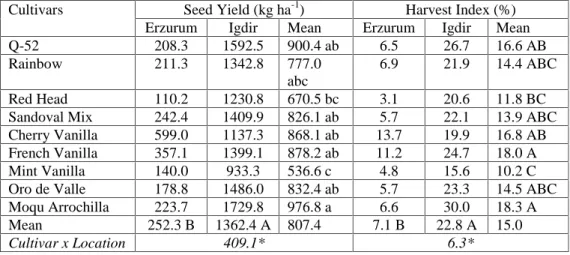Original scientific paper 10.7251/AGRENG1702033T UDC 633.192(560)
STUDIES ON THE ADAPTATION OF QUINOA (CHENOPODIUM
QUINOA WILLD.) TO EASTERN ANATOLIA REGION OF
TURKEY
Mustafa TAN
1, Süleyman TEMEL
2*1Ataturk University, Faculty of Agriculture, Department of Field Crops, Erzurum, Turkey 2Igdir University, Faculty of Agriculture, Department of Field Crops, Igdır, Turkey
*Corresponding author: stemel33@hotmail.com
ABSTRACT
Quinoa (Chenopodium quinoa Willd.), an Andean crop, is native food plant of high nutritional value and its cultivation is increasing rapidly in the World. Background studies should be conducted on the determination of appropriate quinoa varieties for different ecologies for its cultivation to become widespread in a healthy way. This study was conducted in 2015 and 2016 in Erzurum and Igdir non-irrigation conditions in the Eastern Anatolia of Turkey. The locations have different ecological characteristics from each other. The field experiments were conducted with 9 varieties in each location in a randomized complete blocks experimental design with four replications. The grain yield and some related characteristics were examined in the study. The grain yield and related characteristics of quinoa varied significantly depending on varieties and locations in the study. According to the two-year results, quinoa cultivation is a risky in Erzurum which has a high altitude and short vegetation period. The grain yields ranged between 110-599 kg ha-1and was found to be quite low. In the Igdır location, 933-1646 kg ha-1of seed yield was obtained from the varieties. The earliest cultivar is Q-52, it has matured in Erzurum at 102 days, Igdir at 118 days. The latest maturation (138 days) was determined in the Oro de Valle cultivar in Igdir conditions. According to these results, moqu Arrochilla, Q-52, Oro de Valle, French Vanilla and Rainbow cultivars can be recommended for non-irrigated conditions of these locations provided that it is seeded early in the spring. However, Erzurum and similar locations are not suitable for the agriculture of this plant due to short plant growing period.
Key words: Chenopodium quinoa, adaptation, seed yield, highlands, dry conditions.
INTRODUCTION
The quinoa (Chenopodium quinoa Willd.), which originated from the South America, has become highly popular among health-conscious consumers throughout the world. For this reason, studies have been started on adaptation and breeding in many countries. The importance of quinoa is that the seeds have a high
nutritional value. The average percentage of protein in the seeds varies from 7.5% to 22.1% depending on the variety (Cardozo and Tapia, 1979; Wright et al., 2002). The quinoa seeds, which contain all the amino acids needed by the human body, are in the full protein category (Johnson and Aguilera, 1980). Another important feature of the quinoa is that it is gluten-free. In this regard, it is an important source of food for celiac patients (gluten allergy) to meet protein and carbohydrate needs (Jacobsen, 1993). Its seeds are rich in minerals such as Ca, Mg, K, Fe, Cu and Mn and A, B, C and E vitamins (Repo-Carrasco et al., 2003).
Quinoa seeds with high nutritional value are used in human nutrition in many different forms. Its consumption is increasing day by day, especially in USA and EU countries. For this reason, the importance of quinoa agriculture and production is increasing. More scientific research is needed in different regions in order for quinoa farming to spread healthily. One of the most common failures in quinoa cultivation is the lack of appropriate genotypes. There are thousands varieties or ecotypes of quinoa both cultivated and wild in South America. It is important to test these materials in various ecologies to determine their suitability. Because the yield varies greatly depending on genotypes and locations (Miranda et al., 2012). There are many records that quinoa is resistant to abiotic stress factors and is grown at high altitudes (Jacobsen, 2003; Bhargava et al., 2007). But, adaptation studies have to be carried out in order to determine appropriate varieties in different ecologies. Eastern Anatolia Region is the highest altitude region of Turkey and the plant growing season is very short. However, there are microclimates in the region that have different ecological characteristics. It is expected that the performances of the different genotypes vary in different microclimates within the region. The main goal of this study is to evaluate the adaptability of some quinoa cultivars in two different locations of Eastern Anatolia Region.
MATERIALS AND METHODS
The study was conducted in non-irrigated experimental areas of Ataturk University Faculty of Agriculture (Erzurum), and Igdir University Faculty of Agriculture (Igdir) in 2015 and 2016. Nine quinoa (Chenopodium quinoa Willd.) cultivars obtained from different sources at two different locations were evaluated for seed yield and related characteristics. Field experiments were established on March 29th, 2015 and April 6th, 2016 in Igdir; May 5th, 2015 and May 10th, 2016 in Erzurum. In the each experiment, 9 quinoa cultivars were sown in a randomized complete blocks experimental design with four replications. During the seeding, 2500-3000 g ha-1seeds were spread with 35 cm row spacing by hand at 1.5-2 cm sowing depth on parcels (Tan and Yondem, 2013; Geren et al., 2015). Plot size was 6 rows of 4 m, with an inter-row spacing of 0.35 m. Nitrogen was supplied at sowing (75 kg N ha-1) and again during vegetative growth before flowering (50 kg ha-1). Phosphorus
done by mechanical methods like cutting and picking. Harvests by hand in the end of September were done at physiological maturity, which was defined as the date when seeds from the main panicle become resistant when pressed (Bertero et al., 2004). The maturation period, plant height, seed yield and harvest index were determined for the cultivars that came to harvest stage.
The data obtained from the study were subjected to the variance analysis according to the randomized complete blocks experimental design. Differences between the averages were determined with the LSD multiple comparison test. Since the first year data cannot be obtained in the Erzurum location, the results are one-year.
Table 1. Monthly temperature and precipitation during the study months of 2015, 2016 and long year average in Erzurum and Igdir locations.
Months
Temperature (0C) Precipitation (mm) Erzurum Iğdır Erzurum Iğdır LYA 2015 2016 LYA 2015 2016 LYA 2015 2016 LYA 2015 2016 April 5.5 5.3 7.1 13.3 16.4 14.7 51.4 88.6 39.4 34.5 44.1 20.1 May 10.6 10.6 10.5 17.8 21.3 18.7 70.3 81.5 64.8 47.1 41.5 23.5 June 14.9 17.0 14.8 22.1 28.5 23.0 46.3 28.5 88.6 33.0 27.8 26.9 July 19.3 21.2 19.0 25.9 31.8 26.2 26.0 5.8 17.8 13.8 3 32 August 19.4 21.2 21.0 25.1 30.2 27.5 15.9 38.8 13.6 9.6 14.3 7.8 September 14.5 18.3 12.7 20.0 27.2 20.2 22.7 3.9 17.6 11.1 1.4 19.8 Total/Mean 14.0 15.6 14.2 20.7 25.9 21.7 232.6 247.1 241.8 149.1 129.4 110.1 LYA: Long Year Average
Locations where the studies are conducted have very different ecological characteristics (Table 1 and 2). Erzurum is the province which has the highest altitude in the Eastern Anatolia Region with its location 1860 m above sea level. Winter period is long, cold and snowy, summer months are relatively cool and short. Last frosts of spring may extend to May and first frosts of autumn start in September. Therefore, the plant cultivation season is shorter in Erzurum than in other provinces. Igdir is the province which has the lowest altitude in the region with its 876 m altitude. The plant cultivation season is long in Igdir which has the characteristics of microclimate in the Eastern Anatolia Region. Summer months are hot and dry, evaporation is high. Thus, agricultural soils usually have saline characteristics. While locations are similar in terms of the soil texture class, they are different with regard to electrical conductivity (EC), pH, CaCO3and available
phosphorus and potassium for plants. The soils in Igdir location have the characteristics of being slightly saline, slightly alkaline and mid-calcareous, differently from Erzurum location (Table 2).
Table 2. Some physical and chemical properties of soils in research areas Soil Properties Erzurum Igdir Texture class Clay-loamy Clay-loamy
EC (ms cm-1) 0.48 2.00 pH 7.1 7. 9 CaCO3 (%) 2.5 6.5 K (kg K2O ha -1 ) 1380 3430 P (kg P2O5ha-1) 74 80 Organic matter (%) 1.4 1.6
RESULTS AND DISCUSSIONS
Days to harvest of quinoa varied significantly with regard to varieties and locations, and the variety x location interaction was found to be statistically significant (Table 3).
Table 3. Days to harvest and plant height of some quinoa cultivars grown in Erzurum and Igdir non-irrigated conditions.
Cultivars Days to Harvest (days) Plant Height (cm) Erzurum Igdir Mean Erzurum Igdir Mean Q-52 102 118 110 F 55.4 90.4 72.9 BC Rainbow 128 136 132 A 80.6 100.2 90.4 A Red Head 124 132 128 BC 79.8 100.7 90.3 A Sandoval Mix 121 133 127 C 73.3 100.5 86.9 A Cherry Vanilla 125 134 129 ABC 71.5 100.4 86.0 A French Vanilla 109 137 123 D 64.3 99.4 81.9 AB Mint Vanilla 129 135 132 A 78.2 94.2 86.2 A Oro de Valle 122 138 130 AB 62.0 101.0 81.5 AB Moqu Arrochilla 110 118 114 E 57.3 77.3 67.3 C Mean 119 B 131 A 125 69.2 B 96.0 A 82.6 Cultivar x Location 5.3** 10.1*
*: 0.05, **: 0.01, Upper case within the same column and row are significantly different at 1%.
The earliest cultivar is Q-52, it has matured in Erzurum at 102 days, Igdir at 118 days. The latest maturation (138 days) was determined in the Oro de Valle cultivar in Igdir conditions. Although the location of the Igdir is warmer than that of Erzurum, because of early seeding, cultivars have been maturing longer. Quinoa is
made late. Differences in the maturation period due to genotypes and locations are also revealed in other studies (Berterao et al., 2004; Szilagyi and Jornsgard, 2014). The plant height of the quinoa cultivars showed significant differences due to genetic characteristics and different ecological factors (Table 3). Because of the longer development period in the Igdir location, the plants were longer than the Erzurum location. Oro de Valle (101.0 cm) in Igdir and Rainbow (80.6 cm) in Erzurum were found as the tallest cultivars. The differences in the plant heights of cultivars may have resulted from their genetic properties and different reactions to the environment conditions. Similar results have been found in studies conducted in other regions with different ecological characteristics using different genotypes (Pulvento et al., 2010; Bhargava et al., 2007). Seed yields in the study showed significant changes depending on the locations and cultivars (Table 4). Moqu Arrochilla (976.8 kg ha-1) was the most productive cultivar as the average of the locations. Seed yield in the Igdir location (1362.4 kg ha-1) is significantly higher than the Erzurum location (252.3 kg ha-1). The low seed yields in the Erzurum location are quite obvious (110.2-599.0 kg ha-1). Cultivar x location interaction was found to be important in seed yield (P<0.05). The highest seed yield was determined in the Moqu Arrochilla cultivar grown in Igdır conditions, followed by Q-52, Oro de Valle, French Vanilla and Rainbow varieties grown in the same location.
Table 4. Seed yield and harvest index of some quinoa cultivars grown in Erzurum and Igdir non-irrigated conditions.
Cultivars Seed Yield (kg ha-1) Harvest Index (%) Erzurum Igdir Mean Erzurum Igdir Mean Q-52 208.3 1592.5 900.4 ab 6.5 26.7 16.6 AB Rainbow 211.3 1342.8 777.0
abc
6.9 21.9 14.4 ABC Red Head 110.2 1230.8 670.5 bc 3.1 20.6 11.8 BC Sandoval Mix 242.4 1409.9 826.1 ab 5.7 22.1 13.9 ABC Cherry Vanilla 599.0 1137.3 868.1 ab 13.7 19.9 16.8 AB French Vanilla 357.1 1399.1 878.2 ab 11.2 24.7 18.0 A Mint Vanilla 140.0 933.3 536.6 c 4.8 15.6 10.2 C Oro de Valle 178.8 1486.0 832.4 ab 5.7 23.3 14.5 ABC Moqu Arrochilla 223.7 1729.8 976.8 a 6.6 30.0 18.3 A Mean 252.3 B 1362.4 A 807.4 7.1 B 22.8 A 15.0
Cultivar x Location 409.1* 6.3*
* and lower letters: 0.05, ** and upper case: 0.01, Different letters within the same column and row are significantly different at 1%.
The Igdir location has a temperate climate than Erzurum (Table 1). Plants in this area were planted earlier and had a longer development period. Also, the fact that the soil of the region has a slightly saline character may be effective for high yields. Because the quinoa performs better in slightly saline soils (Jacobsen, 2003; Wilson et al., 2002). In Erzurum, seed yields were found to be very low because
the plants could not find a sufficient growth period. Although plants have technically reached harvesting stage, the majority of their panicles have not been seeded. Studies conducted with quinoa varieties in different parts of the world have shown that the seed yield varies between 250-5000 kg ha-1. These results are due to the different performance of the varieties in different ecological conditions (Miranda et al., 2012). The harvest index values of quinoa varieties varied significantly between 10.2-18.3% (Table 4). Moqu Arrochilla, French Vanilla, Cherry Vanilla and Q-52 cultivars have higher harvest index than others. Since the location of Igdir is a more suitable for seed production, harvest index values in this locality are found high. Bhargava et al. (2007) and Bertero et al. (2004) found significant differences in quinoa harvest index according to varieties and locations.
CONCLUSION
The results of this study revealed that quinoa can be grown in the non-irrigated conditions of Eastern Anatolia, a high altitude region in Turkey. Quinoa has a high yield potential in Iğdır and similar locations which have low altitude and long cultivation season. Moqu Arrochilla, Q-52, Oro de Valle, French Vanilla and Rainbow cultivars can be recommended for non-irrigated conditions of these locations provided that it is seeded early in the spring. However, Erzurum and similar locations are not suitable for the agriculture of this plant due to short plant growing period.
ACKNOWLEDGEMENTS
This study was supported by the Scientific and Technological Research Council of Turkey (TÜBİTAK, Project No: TOVAG-214O232).
REFERENCES
Bertero H.D., De La Vega A.J., Correa G., Jacobsen S.E., Mujica A. (2004).
Genotype and genotype by environment interaction effects for grain yield and grain size of quinoa (Chenopodium quinoa Willd.) as revealed by pattern analysis of international multi environment trials. Field Crops Research, vol. 89, pp. 299-318.
Bhargava A., Shukla S., Ohri D. (2007). Genetic variability and interrelationship among various morphological and quality traits in quinoa (Chenopodium quinoa Willd.). Field Crops Research, vol. 101, pp. 104-116.
Cardozo A., Tapia M. (1979). Valor nutritivo. In: Tapia M., Gandarillos H., Alandia S., Cardozo A., Mujica A. Quinoa y kaniwa, cultivos Andinos. Bogota CIID, Oficina Rgiond para la America Lotina, pp. 149-192, ISBN: O-88936-200-9.
Geren H., Kavut Y.T., Altınbaş M. (2015). Effect of different row spacings on the grain yield and some yield characteristics of quinoa (Chenopodium quinoa Willd.) under Bornova ecological conditions. Journal of Ege University Faculty of Agriculture, vol. 52(1), pp. 69-78.
Jacobsen S.E. (2003). The worldwide potential for quinoa (Chenopodium quinoa Willd.). Food Reviews International, vol. 19(1-2), pp. 167-177.
Jacobsen S.E., Jorgensen I., Stolen O. (1994). Cultivation of quinoa (Chenopodium quinoa) under temperate climatic conditions in Denmark. The Journal of Agricultural Science, vol. 122, pp. 47-52.
Johnson R., Aguilera R. (1980). Processing Varieties of Oilseeds (Lupine and Quinoa), In: Report to Natural Fibers and Foods Commission of Texas, 1978-1980 (Reported by D. Cusack, 1984, The Ecologist, vol. 14, pp. 21-31.
Miranda M., Vega-Galvez A., Quispe-Fuentes I., Rodriguez M.J., Maureira H., Martinez E.A. (2012). Nutritional Aspects of six quinoa (Chenepodium quinoa willd.) ecotypes from there geographic areas of Chile. Chilean Journal of Agricultural Research, vol. 72(2), pp. 175-181.
Pulvento C., Riccardi M., Lavini A., D’Andria R., Iafelice G., Marconi E. (2010). Field trial evaluation of two Chenopodium quinoa genotypes grown under rain‐ fed conditions in a typical Mediterranean environment in South Italy. Journal of Agronomy and Crop Science, vol. 196(6), pp. 407-411.
Repo-Carrasco R., Espinoza C., Jacobsen S.E. (2003). Nutritional value and use of the Andean crops quinoa (Chenopodium quinoa) and kaniwa (Chenopodium pallidicaule. Food Reviews International, vol. 19(1-2), pp. 179-189.
Schulte auf’m Erley G., Kaul G., Kruse M., Aufhammer W. (2005). Yield and nitrogen utilization efficiency of the pseudocereals amaranth, quinoa and buckwheat under different nitrogen fertilization. European Journal of Agronomy, vol. 22, pp. 95-100.
Szilagyi L., Jornsgard B. (2014). Preliminary agronomic evaluation of Chenopodium quinoa Willd. under climatic conditions of Romania, Scientific Papers. Series A. Agronomy, University of Agronomic Sciences and Veterinary Medicine of Bucharest, Faculty of Agriculture, Romania, Vol: LVII: 339-343. Tan M., Yondem Z. (2013). A new crop for human and animal nutrition: Quinoa
(Chenopodium quinoa Willd.). Alınteri, vol. 25, pp. 62-66.
Wilson C., Read J., Abo-Kassem E. (2002). Effect of mixed-salt salinity on growth and ion relations of a quinoa and a wheat variety. Journal of Plant Nutrition, vol. 25, pp. 2689-2704.
Wright K.H., Pike O.A., Fairbanks D.J., Huber C.S. (2002). Composition of Atriplex hortensis, sweet and bitter Chenopodium quinoa seeds. Journal of Food Science, vol. 67(4), pp. 1383-1385.
Yazar A., Sezen A.M., Bozkurt Çolak Y. (2013). Yield response of quinoa (Chenopodium quinoa Willd. Q52) to saline and fresh water under the Mediterranean climatic conditions. International Conference on Sustainable Water Use for Securing Food Production In The Mediterranean Region Under Changing Climate, 10-15 March 2013, Agadir-Morocco.


